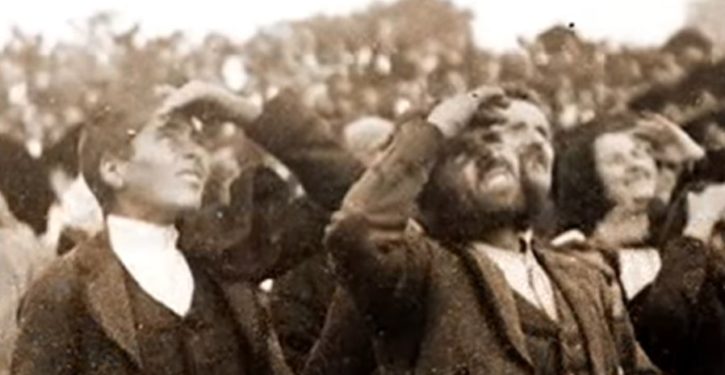
This is the first in a small series of articles that will look at pairings of events or phenomena in the century that ran from 1917 to 2017. The year 1917 was in many ways a very remarkable one, featuring developments on the level of gravity that many today would assign to the events of 2017. Historians would probably hold that it is too soon to have a usefully historical perspective on the last century. But it is not too soon to reflect deeply on them, or take note of things that will weather the test of time to remain compelling and valuable.
In April 1917, two world-shaking things happened within days of each other. On 6 April 1917, the United States entered World War I, declaring war on Germany with a resolution of Congress.
On 9 April 1917, Vladimir Lenin gathered with 31 “comrades” at a train station in Zurich to begin a week-long journey to St. Petersburg (referred to at the time as Petrograd, to avoid the overly Germanic “Petersburg” while Imperial Russia was at war with Imperial Germany).
Will this presidential election be the most important in American history?
On 26 June 1917, the first American troops arrived in France at the port of St. Nazaire. It wouldn’t be until 21 October that U.S. units, which arrived green and ill-trained, were assigned a combat mission in northern France.
On 7 November 1917, Lenin and his comrades launched the Bolshevik revolution, taking down the shaky provisional government established upon the abdication of the Czar in March 1917.
Between 6 April and 7 November 1917, the first group of a pair of 20th-century “visitations” reportedly occurred near a small village in Portugal. Many readers know immediately that I refer to the reported visions of the Virgin Mary at Fatima. Others may not be familiar with this story.
But it interested me in recent weeks to read the new book by Paul Kengor, A Pope and a President, and learn from him that Ronald Reagan had taken a great interest in the apparitions reported at Fatima in 1917. Reagan’s good friend Pope John Paul II took them very seriously, and indeed in 1984 obeyed what he believed were Mary’s instructions to consecrate Russia, in particular – but John Paul II included the whole world in this act – to her “Immaculate Heart.”
Like Reagan, I am a Protestant, and like Paul Kengor, I am not recounting these things to convince anyone one way or the other about the apparitions at Fatima. The timing of them is remarkable, given the reported content of the “three secrets” communicated in the third of the visitations. But Marian theology is not part of Protestant doctrine, and I will state up front that I don’t hold it to be necessary to accept the visitations reported at Fatima as a certified miracle. There are potential reasons for skepticism based solely on the content of the “three secrets,” aside from any empirical forensic inquiry.
Kengor is clear about this himself; he doesn’t try to oversell the Fatima apparitions (although my sense is that he takes them to heart).
However, he reports that there is credible eyewitness testimony from many people who were present during the later of the six apparitions – which started on 13 May 1917 and ran monthly through 13 October 1917 – that something did happen at Fatima.
Kengor recounts that there were an estimated 70,000 people who showed up for the final apparition on 13 October. There are numerous accounts of a vision of Mary on that day, many of them from skeptical, non-religious observers who reported not only seeing her, but seeing a vision of strange activity by the sun. What they saw affected them profoundly.
If you are interested in further research, there are plenty of resources online. Paul Kengor’s book is a good place to start. (One thing he emphasizes is the extreme care the Catholic Church takes in its approach to miracles, and how few of them have actually been certified.)
The point of referring to the events at Fatima here is not to discuss theology, but to begin framing the development of a century in human history unlike any other.
It would take a whole book, or more, to fully expound on the threads I think worth bringing together. This little series of articles will not be that book.
Instead, I want to present a set of pairings in each article that for me illuminates the gripping sense of power and meaning in this century running from 1917 to 2017. In light of all that has happened, it would make as little sense to leave out Fatima as it would to leave out Israel, Soviet Communism, World War II, or Reagan and his contemporaries.
It would, on the other hand, be characteristic of this past century to censor Fatima, out of a pious, narrow-minded zeal to demonstrate empiricism by not even discussing the inconclusive or inexplicable. Litmus-test cognition has become a mode of thought deeply entrenched in our civilization, as if even to discuss something is to pronounce an endorsement of wrong thinking, or proclaim fealty to it.
We’ll look at that phenomenon in the pairing of a later article. For now, let my objection to that primitive and limiting mode of thought be the entrée for Fatima, and its paired phenomenon, the apparitions reported at Medjugorje (in Bosnia-Herzegovina, formerly part of Yugoslavia) starting in the 1980s.
Fatima
The timing, again, was quite remarkable. In the year that set the United States and Russia on the collision course that charted so much of the 20th century, the visions of Mary at Fatima occurred in six installments from May to October.
The first report of Mary at Fatima came from three shepherd children, who told others that they saw her in the hills where they were tending sheep on 13 May. Under intense questioning (including some frustration and embarrassed anger from their own families), the children maintained their story. And as adults began showing up for the promised returns in the following months, they too reported seeing Mary.
On 13 July 1917, the three children – Lucia dos Santos (10), Francisco Marto (9), and Jacinta Marto (7) – reportedly received from the apparition three “secrets,” which they were forbidden at the time to reveal. The two Marto children, brother and sister, perished in the influenza epidemic after World War I before the “secrets” were told. The third, their cousin, became Sister Lucia, who spent her life as a nun and lived until 2005. She disclosed parts of the first two secrets during the 1920s (in conjunction with later, related revelations she reported receiving), and then those secrets in summary in 1941.
The third secret, she wrote down at the order of her bishop, in 1944, directing that it not be opened for inspection until 1960. (She believed she was doing this under the guidance and approval of Mary.)
The first “secret” was a vision of hell, which affected the children greatly (the secret explained that Mary prepared them and shielded them in some way so that they would not be overcome by the vision).
The second is the most famous of the secrets, and had to do with Russia – undoubtedly an odd topic for Portuguese shepherd children in July 1917. This is the text used to lay out the second secret (emphasis added):
[Mary speaking] You have seen hell where the souls of poor sinners go. To save them, God wishes to establish in the world devotion to my Immaculate Heart. If what I say to you is done, many souls will be saved and there will be peace. The war is going to end: but if people do not cease offending God, a worse one will break out during the Pontificate of Pope Pius XI. When you see a night illumined by an unknown light, know that this is the great sign given you by God that he is about to punish the world for its crimes, by means of war, famine, and persecutions of the Church and of the Holy Father. To prevent this, I shall come to ask for the Consecration of Russia to my Immaculate Heart, and the Communion of reparation on the First Saturdays. If my requests are heeded, Russia will be converted, and there will be peace; if not, she will spread her errors throughout the world, causing wars and persecutions of the Church. The good will be martyred; the Holy Father will have much to suffer; various nations will be annihilated. In the end, my Immaculate Heart will triumph. The Holy Father will consecrate Russia to me, and she shall be converted, and a period of peace will be granted to the world.
It is obvious to assume that “Russia spreading her errors throughout the world” referred to the thoroughly disruptive and grotesquely sanguinary model of Marxist-socialist revolution, which indeed resulted in wars, persecutions of the church, and various nations being annihilated.
I will leave it at that, for the most part, since my purpose here is to frame the 20th century for further thought, rather than to exhaustively treat every topic.
The third secret of Fatima was kept closely guarded for many years, even after it was seen by the pope in 1960. It turned out to be a vision of an attack on the pope and other Christians – a vision that many people think came true on 13 May 1981, when a would-be assassin, a Turk named Mehmet Ali Agca (probably contracted by the then-Communist Bulgarian intelligence service), attempted to slay Pope John Paul II.
It is outside the scope of my project here, but I note in passing that Paul Kengor has assembled material never seen before to make the case that the Bulgarians indeed put out the hit on the pope, and that they were under the direction of Moscow; specifically, the Soviet GRU – the military intelligence service, as opposed to the KGB.
As always, Kengor is careful and balanced in his treatment. I won’t argue the case one way or the other.
For me, it is Reagan’s interest in Fatima – something I never knew of before (and it seems few people did) – that is arresting. The content of the three secrets is certainly striking: hell; the “errors” of Russia and the devastation to be wrought by those errors; and a distinctive attack on the pope and other believers.
Medjugorje
The signal service done by Kengor’s book is to demonstrate, by juxtaposing Reagan’s and John Paul II’s interest in both Fatima and Medjugorje, the illuminating quality these two series of events have for each other.
The visitations in Medjugorje began on 24 June 1981, when two teenagers, Mirjana Dragićević and Ivanka Ivanković, reported seeing the Virgin Mary. The next day, four more local teenagers reported seeing her: Marija Pavlović, Jakov Colo, Vicka Ivanković, and Ivan Dragićević.
Their experience was different from that in Fatima. The young people at Medjugorje did not report a small, singular set of profound, seemingly prophetic revelations, but a series of ongoing and less specific ones. Others very soon began coming to Medjugorje to see the apparitions of Mary. (The others have reported seeing her; as in Fatima, however, it is only the original six who hear her speak.)
Paul Kengor recounts that at the time, the teenagers’ priest was under great pressure from the Yugoslav state authorities to get his young parishioners to recant. He was persecuted and imprisoned for his failure to comply, although the state did not directly persecute the young people.
Ultimately, the teens reported receiving a group of ten “secrets,” which have so far not been revealed. The six teens are now middle-aged adults, but to date, none of them has yet believed that he or she received permission to reveal the secrets.
They have, however, reported on other conversations with “the Lady.” Because their experience has been different from that of the children in Fatima, which ceased in terms of localized appearances and specific revelations after six months, I won’t go into the accounts of their interactions here.
But one communication has caught the eye of many, including mine. In 1981, six months after the assassination attempt on John Paul II, the apparition of Mary is said to have conveyed this message to the Yugoslav-Bosnian teens:
Russia will come to glorify God the most; the West has made civilization progress, but without God, and act as if they are their own creator.
Westerners in general became aware of this apparent prophecy from a BBC special on Medjugorje aired in 1986.
The language and sentiments in the Medjugorje visitations are said to be relatively simplistic, something some critics complain about. The statement above, for example, would not mean that the West’s “civilization progress” has literally been made “without God” – that is not a Christian perspective – but rather that humans have come to believe (and in many cases consciously insist) that it was made without God. The point would be that there is no God-consciousness in their spirits, and no humility about their dependence on God.
The simplified elisions of the communications at Medjugorje can require interpolation, and might make them seem too childlike to take seriously, especially for non-believers. The apparition at Fatima spoke more explicitly and magisterially.
That said, however, there is a tremendous sense among many Christians in the West today that their civilization indeed does precisely what the apparition said: “act as if they are their own creator.” The Medjugorje revelation resonates strongly in that regard.
In the 1980s, it would not have resonated nearly as much – especially in juxtaposition with the specter of Soviet Communism.
But with the passage of years and the profound changes in the West’s condition, some authors made the case a couple of years ago that Russia’s intervention in Syria was potentially more beneficial for the suffering Christians there than what the Western powers were doing. (Although the potential may theoretically have been there, I myself wouldn’t agree that that potential has been realized in Russia’s activities.)
Again, the point here is not to convince people one way or the other about the appearances of Mary.
Objectively, however, it would have been counterintuitive and unlikely in the extreme for Yugoslav teenagers in 1981 to make up a statement like the one about Russia and the West.
No one in the Communist nations of Eastern Europe, not even Christian believers, would have put a matter in such terms. Indoctrinated young Communists saw nothing wrong, certainly, with conceiving of themselves as their own creators. They had no motive to criticize that attitude, or to prophesy that Russia would glorify God.
Christians, for their part, understood the West to be a place where people could and did practice their faith without repression or persecution. The blessing of the West was precisely that its people made their progress with God: with full consciousness and acknowledgment of doing so. It was “the errors of Russia” – the brutally coercive implementation of state socialism – that sought to eradicate God-consciousness in the people.
There was no construct of philosophical thought in 1981 – or at any time in the 1980s – that could have led a teenager in either a Communist nation or a Western one to make such a prediction.
After Reagan became aware of the visitation reported at Medjugorje, he found a way to make indirect contact with the young visionaries there, in 1987, through his ambassador to the “European Communities” (precursor to the EU), Alfred Kingon.
Kingon and his wife traveled to Medjugorje that year. In a talk in 1992, Kingon described meeting with Marija Pavlović and a local priest, Father Svetozar Kraljevic. After they had spoken for a while, Marija excused herself and came back with a letter to President Reagan, which she asked if Kingon could deliver.
Kingon did get the letter to Reagan, and recounted afterward that Reagan told him he was “very moved” by it. The president wanted to send a letter back, and apparently did so. Additional details are few, but there seems to have been at least one more communication, an attempted phone call from a Reagan aide which Marija interpreted (erroneously, it appears) as coming from the president himself.
Kengor writes that no such details of Reagan’s close interest in Fatima and Medjugorje have been made public before, and he seems to be quite correct about that.
For a century defined, in the terms of modern history, by the career of Marxist socialism, anchored by Russia’s central and indispensable role, the framing afforded by these two reported visits from the Virgin Mary is quite remarkable. I offer them not for uncritical belief, but for thought. They make our first waypoint on the centenary road.




